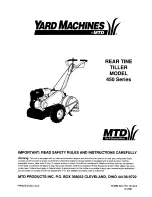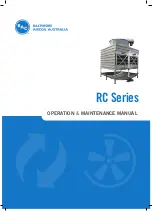
71
c. Leak test chiller as outlined in Steps 3 to 9.
2. If the pressure readings are abnormal for the chiller condition:
a. Prepare to leak test chiller.
b. For cooling machines, check for leaks by connecting a nitrogen bottle with added tracer to allow for
electronic leak detection if possible; otherwise, soap bubble solution is to be used. Raise the pressure to a. If
electronic leak detector is available, ensure small amount of tracer material is added.
c. Plainly mark any leaks that are found.
d. Release the pressure in the system.
e. Repair all leaks.
f.
Retest the joints that were repaired (note suggested test pressure is 138 kPa; maximum allowable
test pressure 310 kPa.
3. Check the chiller carefully with an electronic leak detector or soap bubble solution.
4. Leak Determination
If an electronic leak detector indicates a leak, use a soap bubble solution, if possible, to confirm. Total all leak
rates for the entire chiller. Leakage at rates greater than 0.1% of the total charge per year should be repaired.
Local regulation governs the requirements for when repair of leaks become mandatory. Note
the total chiller leak rate as well as the full charge amount on the start-up report.
5. If no leak is found during the initial start-up procedures, complete the transfer of refrigerant gas from the
storage tank to the chiller. Recover any gas used for leak detection purposes as required per local jurisdiction.
6. If no leak is found after a retest:
a. Perform a standing vacuum test as outlined in the Standing Vacuum Test section, below.
b. b. If the chiller fails the standing vacuum test, repeat leak test and repair.
c. If the chiller passes the standing vacuum test, dehydrate the chiller. Follow the procedure in the
Chiller Dehydration. Charge the chiller with refrigerant.
7. If the chiller is opened to the atmosphere for an extended period, evacuate it before repeating the leak test.
NOTE: Alternate optional leak testing method is to isolate the water circuits and use a portable water heater to
raise the temperature of the cooler and condenser water circuits to approximately 38°C which corresponds to a
pressure of 99.3 kPag.
Temperature / °C
Pressure / kPag
Pressure / kPa
abs
% vaccum
-12.2
-74.1
27.3
75
-9.4
-70.1
31.3
70
-6.7
-65.8
35.6
65
-3.9
-60.9
40.5
60
-1.1
-55.5
45.9
55
1.7
-49.6
51.8
49
4.4
-43
58.4
42
7.2
-35.8
65.6
36
10
-28
73.4
28
12.8
-19.3
82.1
19
15.6
-10
91.4
10
18.3
0.3
101.7
-
21.1
11.4
112.8
-
23.9
23.4
124.8
-
26.7
36.4
137.8
-
Содержание PIC 5+
Страница 26: ...26 VFD not shown Fig 13 Sensors actuators location ...
Страница 52: ...52 Fig 24 19DV control box ...
Страница 53: ...53 1 Power supply 24V AC 2 LEN 3 CCN 4 Ethernet 5 USB Fig 25 19DV HMI box rear view ...
Страница 54: ...54 Fig 26 19DV IOB1 wiring Fig 27 19DV IOB2 wiring ...
Страница 57: ...57 ...
Страница 113: ...113 APPENDIX A SmartView SCREEN AND MENU STRUCTURE ...
Страница 114: ...114 Detailed menu description ...
Страница 116: ...116 APPENDIX B MAINTENANCE SUMMARY AND LOGSHEETS Cont 19DV monthly Maintenance Log ...
















































